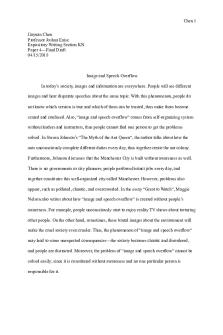DOCEssay 4 - B+ PDF

| Title | DOCEssay 4 - B+ |
|---|---|
| Course | Intro To American History |
| Institution | George Washington University |
| Pages | 2 |
| File Size | 48.3 KB |
| File Type | |
| Total Downloads | 55 |
| Total Views | 137 |
Summary
Professor Brunsman Document Essay 4...
Description
In 1856, Senator Charles Sumner’s “Crime against Kansas” address in the Senate represented not only the Congressional and public divide on slavery but the bitterness that came with it as well. In this speech, Sumner denounces slavery, especially its use in the new Kansas Territory. He attests that “Against this Territory, thus fortunate in position and population, a crime has been committed, which is without example in the records of the past… (MP p. 391).” Moreover, he sees this extension of slavery originating from “a depraved longing for a new slave State (MP p. 391)” and thus an attempt at putting the power of slavery in the federal government. With these claims, Charles Sumner points to Senator Butler of South Carolina and Senator Douglas of Illinois as the proponents of this horrible affliction. However, he does so by allegorically relating slavery to a mistress of Butler’s who is ugly to everyone except him. With this he attempts to make the point that the senator will stop at nothing to defend the righteousness of slavery. Additionally, he criticizes the senator for being hypocritical in the sense that Butler labels his opponents as fanatical when he himself is a fanatic in regards to the Kansas territory. As for Senator Douglas, Sumner states that his discourse for propagating slavery in Kansas is tyrannical in nature and that while he may fight for that cause, he’ll have a heavy opposition. This speech depicts the rising tensions that were spreading throughout the United States and galvanizing citizens at that time. The schism between Americans was so strong that even violence wasn’t off the table for people when it came to settling their differences on this issue. Not only did fighting break out between abolitionists and anti-abolitionists in the Kansas territory over whether to allow slavery, but even in the Senate as well, when Charles Sumner was beaten by Senator Preston Brooks after he gave that speech (LEP p. 478-481).
More of this divide can be noted in the letters of Axalla John Hoole (MP p. 389-390), a southerner who fought for slavery in the civil war that broke out in Kansas, otherwise known as “Bleeding Kansas”. In these letters to his brother and mother, Hoole recounts several bloody encounters with abolitionists. In one of the encounters, he describes a tense standoff between an abolitionist and anti-abolitionist at an election. After a quarrel ensued between the two opposing men, the abolitionist stabbed his counterpart who was a man named Lyle, and then was quickly taken prisoner to prevent the abolitionists from rescuing him or Lyle’s friends from killing him. This proved how feverish each side was on this issue as bloodshed was starting to be used to settle their disputes. The significance of both of these documents is that it foreshadowed events to come only a few short years later. It finally brought to light what was apparent all along; slavery was a deep seeded issue that brought out intense emotions from those who opposed and supported it. The events in Kansas and on the Senate floor were catalysts to the American Civil War and proved that solving this issue would not come with words but with force....
Similar Free PDFs

DOCEssay 4 - B+
- 2 Pages

Engwr #4- B - Grade: B
- 7 Pages

Essay 4 - B+
- 2 Pages

4 - Nota: b
- 2 Pages

ICE #4 - Grade: B
- 3 Pages

4 Linfomi T - B
- 6 Pages

Assignment 4 Answers b
- 6 Pages

Clinical Conditions (B) - 4
- 9 Pages

Swoct 26-4 - Grade: B+
- 8 Pages

Bio 40 B Lab 4
- 10 Pages

Paper 4 Final - Grade: B+
- 6 Pages

B&P cours 4 - Popovici
- 5 Pages

Unit 4 LEQ - Grade: B+
- 2 Pages

Rapport onee - Note: B+4
- 20 Pages

301 2017 4 b - 301
- 24 Pages
Popular Institutions
- Tinajero National High School - Annex
- Politeknik Caltex Riau
- Yokohama City University
- SGT University
- University of Al-Qadisiyah
- Divine Word College of Vigan
- Techniek College Rotterdam
- Universidade de Santiago
- Universiti Teknologi MARA Cawangan Johor Kampus Pasir Gudang
- Poltekkes Kemenkes Yogyakarta
- Baguio City National High School
- Colegio san marcos
- preparatoria uno
- Centro de Bachillerato Tecnológico Industrial y de Servicios No. 107
- Dalian Maritime University
- Quang Trung Secondary School
- Colegio Tecnológico en Informática
- Corporación Regional de Educación Superior
- Grupo CEDVA
- Dar Al Uloom University
- Centro de Estudios Preuniversitarios de la Universidad Nacional de Ingeniería
- 上智大学
- Aakash International School, Nuna Majara
- San Felipe Neri Catholic School
- Kang Chiao International School - New Taipei City
- Misamis Occidental National High School
- Institución Educativa Escuela Normal Juan Ladrilleros
- Kolehiyo ng Pantukan
- Batanes State College
- Instituto Continental
- Sekolah Menengah Kejuruan Kesehatan Kaltara (Tarakan)
- Colegio de La Inmaculada Concepcion - Cebu
